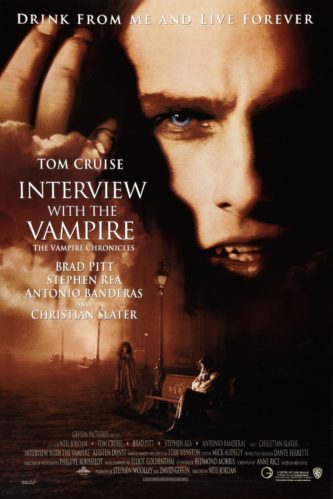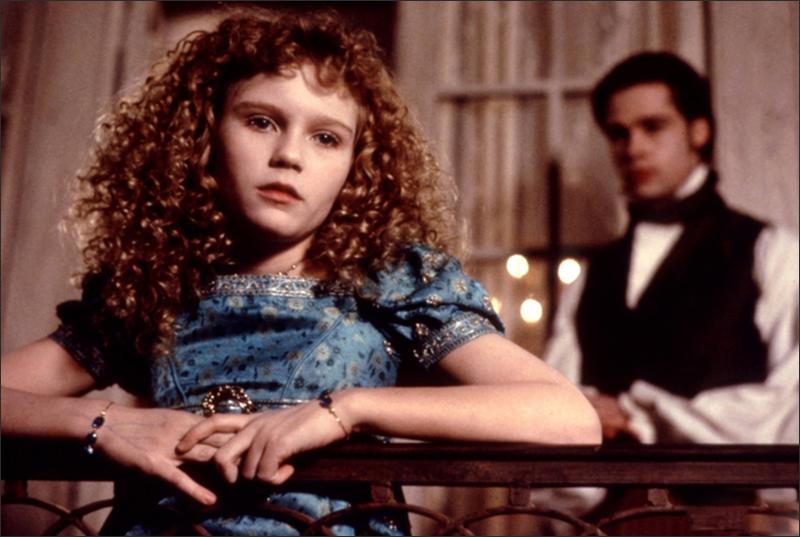 The big budget 1994 movie adaptation of Anne Rice’s classic novel. It’s a handsomely mounted film to be sure, but also a dull and uninvolving one.
The big budget 1994 movie adaptation of Anne Rice’s classic novel. It’s a handsomely mounted film to be sure, but also a dull and uninvolving one.
The director of this lavish adaptation was Ireland’s talented Neil Jordan, who was coming off the mega-successful indie THE CRYING GAME. The true auteur, however, was producer David Geffen, who financed and distributed INTERVIEW WITH A VAMPIRE in November of 1994. Geffen spent nearly 20 years trying to get the film made, and endured the wrath of Anne Rice, who complained incessantly over the years about the direction the project was taking, and also the casting of Tom Cruise in a lead role. Rice changed her stance once the film was released, taking out an eight page ad in the December 23, 1994 issue of Variety, in which she compared Tom Cruise to Lawrence Olivier and called David Geffen “My hero.”
Rice changed her stance once the film was released, taking out an eight page ad in the December 23, 1994 issue of Variety, in which she compared Tom Cruise to Lawrence Olivier and called David Geffen “My hero.”
The film in any event was a hit, and is considered a classic by some. Not me!
In nineties-era San Francisco Luis, a centuries-old vampire, is being interviewed by a naïve young reporter. Luis relates how back in the late 18th Century he was vampirized on the Louisiana plantation where he resided by a suave and snobby European vampire named Lestat.
Lestat teaches Luis how to live as a vampire, which includes hiding from daylight, sleeping in coffins and drinking blood. The kind-hearted Luis is reluctant to drink the blood of humans, and wants to leave Lestat. The latter vampirizes a young girl named Claudia to keep Luis around, and the ploy works. But as the years pass Claudia grows increasingly dissatisfied with her status as a child vampire, and attempts to kill Lestat by injecting a pair of murdered young men with a potion that keeps their blood warm, so Lestat will unknowingly drink the dead boys’ blood, which is fatal to vampires. As planned, Lestat drinks the boys’ blood and expires (or so it seems). Luis and Claudia promptly burn down Luis’ estate and board a ship to Europe.
Wandering Europe in search of fellow vampires, Luis and Claudia wind up in Paris. There they meet the whimsical Santiago and the ominous Armand, who are ensconced in the Theatre des Vampires, where they pretend to be humans pretending to be vampires. This allows them to kill people and drink their blood onstage under the guise that it’s all an act.
Luis allows himself to be drawn into the atmosphere of the Theatre des Vampires, and vampirizes a kindly doll maker so Claudia will have a mother-figure. But Santiago and his fellow vampires stage a coup, trapping Armand and Luis in a bricked-up room and Claudia and her guardian in an open-air pit, where they’re fried by the rising sun.

Luis is pissed, and upon breaking out of the bricked-up room hits the revenge trail. He also meets the still-extant Lestat one last time, and winds up the interview that set things in motion. This is followed by a most unexpected coda.
To be sure, this film looks damn good. The 19th Century scenery, courtesy of the great Dante Ferreti, is quite sumptuous, and the photography, by the equally great Philippe Rousselot, has an appropriately burnished, elegant sheen. But the visual brilliance may be part of the problem: Neil Jordan appears to have focused most of his energy on the film’s look, and so lost track of what was truly important.
To be sure, this film looks damn good.
The relentless philosophical queries that packed Anne Rice’s novel have been largely jettisoned (a good thing if you ask me), just as the novel’s homo-erotic content was toned down considerably. Far more damaging are the characterizations, which have been simplified, if not blunted entirely, with Luis coming off as little more than a whiny slacker and Lestat a spoiled adolescent. The result is a film that’s never as exciting or absorbing as it means to be, and is further crippled by a severely misconceived coda, depicting the Freddy Krugar-esque resurrection of Lestat, that wasn’t in the novel.
Much public ire accompanied the casting of Tom Cruise, but I’d say he’s extremely well chosen as Lestat…
Much public ire accompanied the casting of Tom Cruise, but I’d say he’s extremely well chosen as Lestat, with the character’s overriding arrogance and narcissism perfectly embodied (onscreen and off) by Cruise. What people should have complained about was the choice of Brad Pitt as Luis. Pitt admittedly had a tough time on the film, and his contrived angst is a constant distraction. As for the other actors, Neil Jordan regular Stephen Rae doesn’t have nearly enough screen time to make much of an impression as Santiago; ditto Antonio Banderas as Armand (a major figure in the novel whose role was considerably reduced) and Christian Slater as the interviewer. The most memorable performance, unexpectedly enough, is delivered by 11-year-old Kirsten Dunst as the vampire girl Claudia. The young Dunst reveals herself as a mighty powerful young actress, who in the years since has never quite matched the impact she makes here.
Vital Statistics
INTERVIEW WITH THE VAMPIRE
Geffen Pictures
Director: Neil Jordan
Producers: David Geffen, Stephen Woolley
Screenplay: Anne Rice
(Based on a novel by Anne Rice)
Cinematography: Philippe Rousselot
Editing: Mick Audsley
Cast: Tom Cruise, Brad Pitt, Antonio Banderas, Stephen Rea, Christian Slater, Kirsten Dunst, Thandie Newton, Virginia McCollam, Sara Stockbridge, Louis Lewis-Smith, Domiziana Giordano

